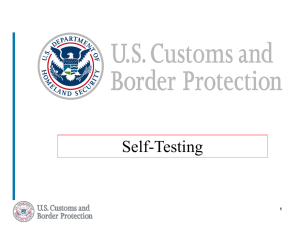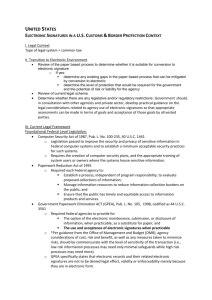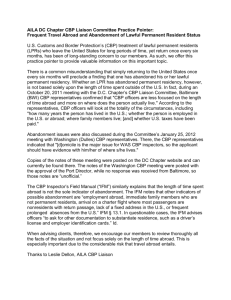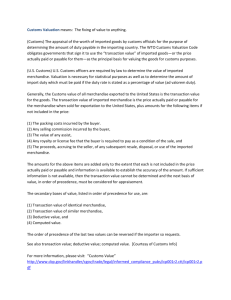Under attack: the first sale rule and US Customs valuation
advertisement
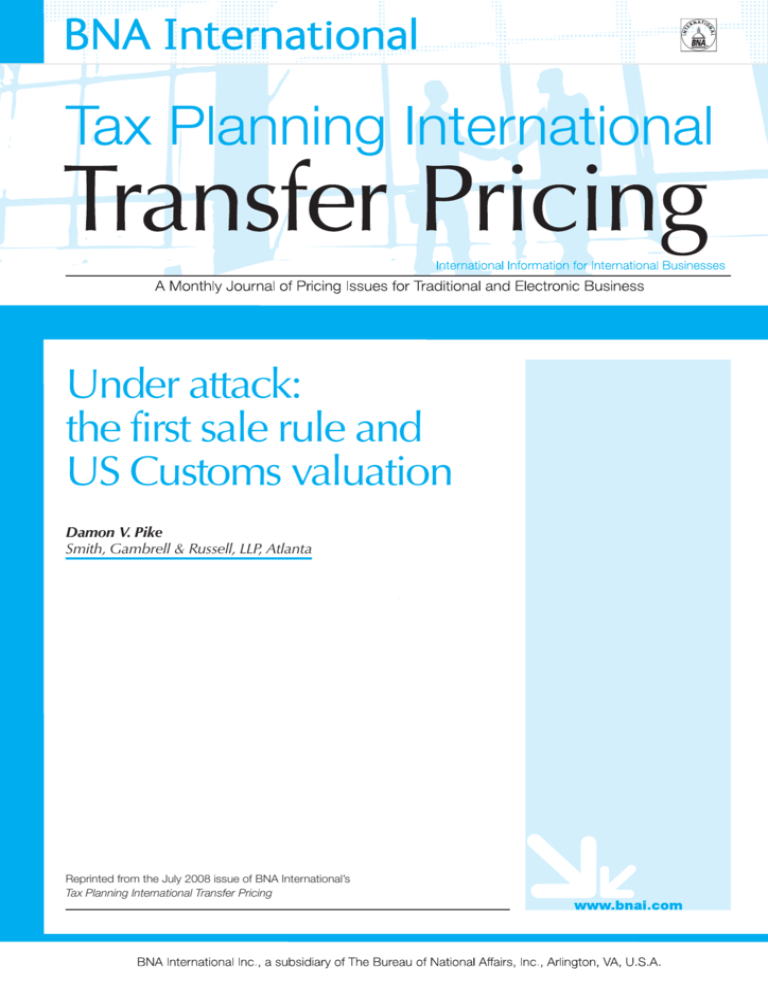
Under attack: the first sale rule and US Customs valuation Damon V. Pike Smith, Gambrell & Russell, LLP, Atlanta Reprinted from the July 2008 issue of BNA International’s Tax Planning International Transfer Pricing Under attack: the first sale rule and US Customs valuation Damon V. Pike Smith, Gambrell & Russell, LLP, Atlanta In a move that caught the US international trade community by surprise, US Customs and Border Protection (CBP) announced its intention early in 2008 to alter its long-standing acceptance of the “First Sale For Export” (FSFE) duty-saving strategy which has been implemented by countless exporters and importers since 1992.1 The agency’s attempt to change its interpretation of a long-standing (and judicially-approved) rule prompted unprecedented opposition from scores of companies, industries, and organisations. Opposition was so widespread that the United States Congress intervened and passed a law which essentially prohibits CBP from making any changes to FSFE until 2011 at the earliest, and mandates that the US International Trade Commission prepare a report on FSFE before the US Secretary of the Treasury makes the final decision about the fate of FSFE. Thus, in a year that CBP had touted as the one of “return to trade facilitation” in which it would resume its traditional role as “partner to the trade”,2 its first major action dealt a blow to any re-engagement with the trade to work together in addressing issues of mutual concern. To understand why CBP erred in pursuing the course that it did, an examination of FSFE (including its impact on transfer pricing), CBP’s notice, and Congress’ reaction is detailed below. I. Judicial precedent and FSFE In 1992, the US Court of Appeals for the Federal Circuit (CAFC) in Washington, D.C. issued a landmark judicial decision which clarified and refined certain earlier decisions in allowing the importer to use as the basis of appraisement for customs valuation the invoice price from a contract manufacturer to a middleman, which then re-sold the merchandise to the US importer.3 At issue in the Nissho Iwai case were contracts which the Metropolitan Transit Authority (MTA) of New York City had signed with the Nissho Iwai American Corporation, a US subsidiary of a Japanese trading company, to manufacture 205 subway cars. The contract specified that the subway cars were to be manufactured by Kawasaki Heavy Industries, Ltd. at a specified unit price based on a formula (which included escalation charges, change order payments, etc.) Purchase orders by Nissho Iwai followed, and Kawasaki manufactured the cars pursuant to the contract specifications and then shipped the subway cars to New York. Kawasaki issued its 2 invoices to Nissho Iwai, which then re-invoiced the MTA at the higher price specified in the contract. Upon importation into the US, CBP used the lower invoice price from Kawasaki to Nissho Iwai to appraise the first shipment of subways cars under the “transaction value” methodology.4 However, for the remaining shipments, CBP used the higher invoice price from Nissho Iwai to the MTA as the transaction value. In using several of its earlier decisions for guidance,5 the CAFC enunciated a clear rule: in a multi-tiered import transaction, if the sale between the manufacturer and the middleman (which middleman purchaser need not be located in the United States) falls within the statutory provision for transaction value, the manufacturer’s price, rather than the price from the middleman to the customer/importer, is used as the basis of customs valuation. Thus, the CAFC ordered CBP to re-appraise the shipments of subway cars on the basis of the Kawasaki-Nissho transaction rather than the Nissho Iwai-MTA transaction. As a result of the Nissho Iwai decision, companies involved in multi-tiered import transactions were henceforth allowed to use the “first sale” in a series of sales to the US importer, which naturally resulted in a lower value declared to CBP for the imported merchandise – and, because most duties are levied on an ad valorem basis, resulted in lower duties. Essentially, the FSFE concept evolved into a three-part test which required: 1. a bona fide sale from the manufacturer to the middleman; 2. that the merchandise be clearly destined for export to the US at the time of the first sale; and 3. that the first sale price be at arm’s length. II. FSFE and related party transactions Armed with the Nissho Iwai judicial decision, many global traders began to identify product flows which might benefit from FSFE. The typical scenario involved US importers purchasing goods from a middleman, which sourced the merchandise from unrelated contract manufacturers. Apparel, footwear, and electronics were just a few of the many industries which utilised this product flow when unrelated contract manufacturers were involved, and thus were able to take advantage of FSFE. However, many companies with related party transactions began to realise that their operational activities were set up in such a way that FSFE could be implemented with minor structuring changes – and without any detrimental impact on their income tax position. The structuring changes centred around what was already becoming, for many, a business reality: global demand for products – coupled with Under attack: the first sale rule and US Customs valuation multi-country sourcing and sales – required that most manufacturing entities separate their domestic sourcing and sales from their international sourcing and sales, for fairly obvious reasons: domestic transactions were much simpler and straightforward to accomplish, while international sales involved a myriad of regulations and complexities (including currency risk, shipping and transport challenges, and – most importantly – transfer pricing concerns) which simply were not present in domestic transactions. normally be determined on the basis of the price paid by the buyer (importer) in the United States, rather than on the first (or earlier) sale in the import transaction chain. CBP stated that its proposed interpretation reflected the conclusions of the World Customs Organisation’s (WCO) Technical Committee on Customs Valuation as set forth in a recently-published document (Commentary 22.1) entitled: “Meaning of the Expression ‘Sold for Export to the Country of Importation’ in a Series of Sales’”.6 Thus, many entities were already operating what was akin to a “trading company” within their organisations, but without the formal structure of such an entity. FSFE highlighted what was, in fact, already a commercial reality for many large, multinational concerns. To take advantage of FSFE, these companies took the final step of formally organising a separate corporate entity to engage in all aspects of managing the flow of raw materials and finished goods across the borders where their companies conducted business. The procedural steps needed to accomplish this were fairly simple: set up separate offices with full-time employees of the “new” trading company, open a bank account in the name of the new company, process all orders and fulfilments through the new company, and negotiate all purchase orders and contracts in the name of the new company. In essence, CBP relied on the Technical Committee’s finding that the Valuation Agreement does not define or otherwise directly address the meaning of the expression “sold for export to the country of importation,” and on their examination of other provisions of the Valuation Agreement (such as where adjustments must be made to the transaction value) to “fill in the gap.” The WCO’s Commentary concluded by stating: Substantively, because the new trading company’s income was consolidated into the parent company’s for income tax purposes, no change in the parent’s company tax position resulted from this re-structuring. However, the one area which required in-depth substantive review was in the area of transfer pricing, that is, in setting up the trading company, how much profit could be assigned to the new company relative to the functions it performed and the risks it undertook in processing international sales and purchases? The answer varied. Because most functions of a trading company are similar, the main variable centred on how much risk the parent company allowed the new trading company to shoulder. For instance, did the new company bear the risk of currency exchange rate fluctuations? Did the new company sell or buy the material/product “ex-works” or CIF at the port of delivery? Based on the answers to these and other questions, global traders documented their findings in a “modified” transfer pricing study which addressed both the income tax and customs rules, and found that a profit of between 5-15 percent was acceptable for both the tax and customs authorities. Thus, by formally setting up these trading companies, multinational companies lowered their duty burden for products shipped into the United States by the same percentage, given that the value declared to CBP was based on the invoice from the manufacturing/parent company to the new middleman/trading company rather than on the invoice from the middleman to the US subsidiary/importer. III. CBP’s Federal Register notice On January 24, 2008, CBP published a notice intended to put a stop to FSFE, which many, many multinational companies had implemented in the years following Nissho Iwai. The agency’s notice, entitled “Proposed Interpretation of the Expression ‘Sold for Exportation to the United States’ for Purposes of Applying the Transaction Value Method of Valuation in a Series of Sales”, solicited comments on this interpretation, pursuant to which transaction value would The Technical Committee is of the view that the underlying assumption of Article 1 of the Valuation Agreement is that normally the buyer would be located in the country of importation and that the price actually paid or payable the transaction value would be based on the price paid by the buyer. The Technical Committee concludes that in a series of sales situation, the price actually paid or payable for the imported goods when sold for export to the country of importation is the price paid in the last sale occurring prior to the introduction of goods into the country of importation, instead of the first (or earlier) sale.7 In relying on this language as the basis for its proposal, CBP also noted that the Technical Committee had concerns about the practical ability of different countries’ Customs administrations to obtain and verify relevant financial and other records relating to FSFE. Thus, the two reasons informing the Technical Committee’s decision were not based on any application of law or precedent, but merely on underlying assumptions about what the drafters of the Valuation Agreement may have intended in the FSFE scenario (given the lack of any direct language or decisions on point) and the concern that customs auditors in certain countries may not have been up to the task of gathering the documentation needed to substantiate an importer’s use of FSFE – notwithstanding the fact that, should the importer fail to use its leverage with the foreign supplier to respond to customs’ request for documentation, the respective Customs authority can (and has every right to) deny the use of FSFE and demand payment of additional duties. In analysing the US statute, CBP followed much the same logic and rationale as the WCO’s Technical Committee, with the same result: a conclusion based on suppositions and practical concerns about the “formidable fact-finding” involved in verification of FSFE transactions by CBP. However, unlike the Technical Committee’s claim that no direct language in the Valuation Agreement or other precedent was available to guide it, a US judicial decision had already “filled in the gap” for CBP. In addressing the prior decisions of the US Court of Appeals for the Federal Circuit (the “last stop” for customs litigation before it reaches the US Supreme Court), CBP dismissed those precedent – including Nissho Iwai – by stating: “. . . the early court decisions that required transaction value to be determined on the basis of the price actually paid or payable in the first sale are based primarily on case law decided under the prior export value law and the similarity of some language from the export value law.”8 3 Under attack: the first sale rule and US Customs valuation However, CBP “glossed over” the fact that the Federal Circuit’s ruling in Nissho Iwai did address FSFE under the current US law – the Trade Agreements Act of 1979, which enacted the Valuation Agreement into US law and provided for transaction value as the principal basis of appraisement. Nissho Iwai had spoken directly to this issue, which the court summarised quite nicely when it wrote in 1992: [t]he rule [FSFE] only applies when there is a legitimate choice between two statutory viable transaction values. The manufacturer’s price constitutes a viable transaction value when the goods are clearly destined for export to the United States and when the manufacturer and the middleman deal with each other at arm’s length, in the absence of any non-market influences that affect the legitimacy of the sales price.9 In essence, CBP attempted with its Notice to overturn a judicial decision with which it did not agree through an administrative procedure that, in and of itself, was not even properly executed according to CBP’s own regulations in revising or revoking rulings –including the scores of FSFE rulings which CBP Headquarters had issued since 1992. Needless to say, the reaction from the US international trade community was swift and almost entirely unfavourable. Over 200 comments were received in opposition from major importers and their representatives, as well as from a host of industry groups and a raft of US Senators and Congressmen, while only a few were filed in support of CBP’s proposed interpretation. The common refrain found throughout these comments centred on CBP’s deviation from standard procedures and its attempt to overturn a judicial decision through a “policy” change cloaked as a “change in interpretation” of a statute. As many commentators noted, US courts are not bound to follow “advisory opinions” of international bodies like the WCO in any event – especially when a judicial decision of the second highest court in the land for customs matters had already spoken to and decided this issue years earlier. IV. Intervention by Congress With such a groundswell against CBP’s attempt to torpedo FSFE, the Congress of the United States took full notice and passed an amendment to the recent “Farm Bill” legislation on May 13, 2008. The amendment essentially “slapped CBP’s hand” for attempting to circumvent the normal “vetting” and administrative procedures. Section 15422 of the bill (H.R. 2419) requires that CBP, for a one-year period, collect declarations from US importers as to whether their imports utilise FSFE, and forward that information to the US International Trade Commission (ITC) on a monthly basis for the duration of the one-year period. At the end of that year, the ITC must prepare a report to Congress setting forth the actual extent of FSFE usage, including the number of importers basing their customs values on FSFE, the tariff classification of goods appraised under FSFE (including which industry sectors use FSFE), and an analysis of the total value of imported goods appraised under FSFE (including by sector) versus the total value of all merchandise imported into the US during the one-year period. Following the report to Congress, the respective committees (Senate Finance and House Ways and Means) will consider the impact of any proposed changes in interpretation of the phrase “sold for export to the United States”, and more importantly, will 4 determine if the statute itself needs to be re-written – which only the Congress can do. In addition, the legislation expresses a “sense of Congress” that, absent any legislative fix, the Commissioner of CBP shall not implement any change in interpretation of the statute prior to January 1, 2011, and that, should any change be contemplated, the CBP Commissioner must first consult with the appropriate congressional committees and its own “Commercial Operations Advisory Committee”. The legislation also stated that any change in interpretation of FSFE must receive the explicit approval of the US Secretary of the Treasury – and not by CBP’s career executives in the Office of Regulations and Rulings at CBP Headquarters. V. Conclusion CBP claimed in its Federal Register that its proposed interpretation of FSFE “establishes a straightforward rule for determining transaction value in a series of sale situation that does not require CBP to engage in formidable fact-finding or to conduct foreign inquiries. This new approach will enable traders to predict with a reasonable degree of accuracy the customs value based on information readily available in the US” 73 Fed. Reg. at 4258. To the contrary, CBP conducts foreign inquiries on a regular basis (such as when it verifies NAFTA claims by Mexican or Canadian producers or seeks costing data from producers in developing countries to support duty-free claims under the Generalised System of Preferences). In addition, this new proposed interpretation upsets years of business planning and certainty, and will only lead to greater uncertainty as businesses try to anticipate the outcome of this issue and plan accordingly. Because international tax and trade professionals in the private sector know that sources of supply (often based on long-term contractual obligations) cannot be moved at whim from one jurisdiction to another, many will be unable to “un-do” what has already taken years of structuring to accomplish should CBP ultimately be successful in ending FSFE. Thus, as with any kind of government action that results in higher taxes, that increase will ultimately be passed on by businesses to the US consumer – the real loser in this entire misguided exercise. CBP should call a halt to this initiative, and instead focus on fostering policies that partner with the trade to facilitate the smooth cross-border flow of merchandise – which creates jobs and economic growth not only in the United States, but around the globe. Damon V. Pike is Counsel with Smith, Gambrell & Russell, LLP in Atlanta, Georgia. He may be contacted at: dpike@sgrlaw.com 1 CBP’s notice was published in the US Federal Register, in which all agencies of the federal government (including the White House) must publish any proposed rules, final rules, Executive Orders, etc. See 73 Fed. Reg. 4,254 (Jan. 24, 2008) 2 See Pike, Damon V. “U.S. Customs re-focuses on trade facilitation and transfer pricing”, Tax Planning International Transfer Pricing, Vol.7, No.7, July 2007. 3 See Nissho Iwai American Corp. v. United States, 982 F.2d 505 (Fed. Cir. 1992). 4 Merchandise imported into the United States is appraised in accordance with Section 402 of the Tariff Act of 1930, as amended by the Trade Agreements Act (TAA) of 1979. See 19 USC. Section 1401a. The preferred method of appraisement is transaction value, which is defined as the “price actually paid or payable for the merchandise when sold for exportation into the United States,” plus certain additions where applicable. See 19 USC. Section Under attack: the first sale rule and US Customs valuation 1401a(b)(1)(A)-(E). Transaction value is, by far, the most commonly used method of appraisement for merchandise imported into the United States and all other major trading nations, which – like the US – have implemented Article VII of the 1979 General Agreement on Tariffs and Trade (now World Trade Organisation, or WTO) pertaining to customs valuation into their domestic legislation. Article VII states that “the customs value of imported goods shall be the transaction value, that is, the price actually paid or payable for the goods when sold for export to the country of importation. . ..” For ease of reference, this Agreement will be referred to hereinafter as the Valuation Agreement. 5 See United States v. Getz Bros. & Co., 55 CCPA 11 (1967); E.C. McAfee Co. v. United States, 842 F.2d 314, 6 Fed. Cir. (T) 92 (Fed. Cir. 1988); Brosterhous, Coleman & Co. v. United States, 737 F. Supp. 1197 (CIT 1990). 6 It should be noted that the members of the WCO’s Technical Committee on Customs Valuation are all government officials from the various customs authorities of the WCO member states. Thus, it should come as no surprise that this committee advocated an interpretation resulting in a higher value, because such an interpretation would result in a higher duty collections for the member states (including the US and all members of the European Union) which currently recognise and accept FSFE in one form or another. 7 73 Fed. Reg. at 4256 (Jan. 24, 2008). 8 73 Fed. Reg. at 4259. The predecessor to the TAA of 1979 based customs valuation on the “export value” of the imported merchandise. See 19 USC. Sections1401a(b) and 1402(d) (1976). 9 982 F.2d at 509 (Fed. Cir. 1992). 5
